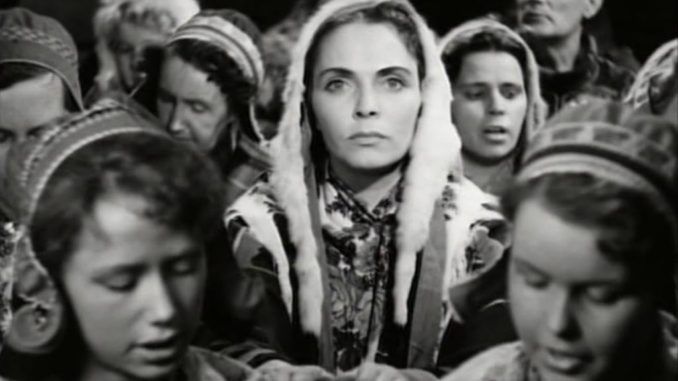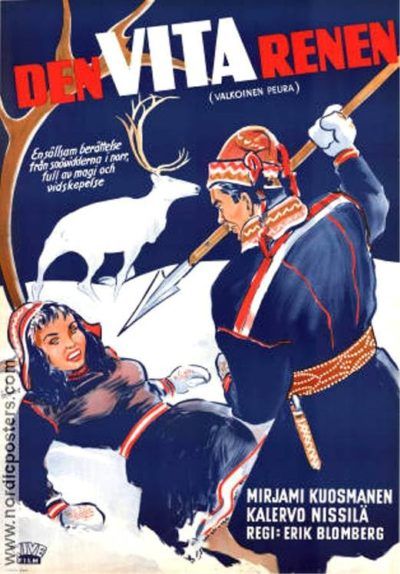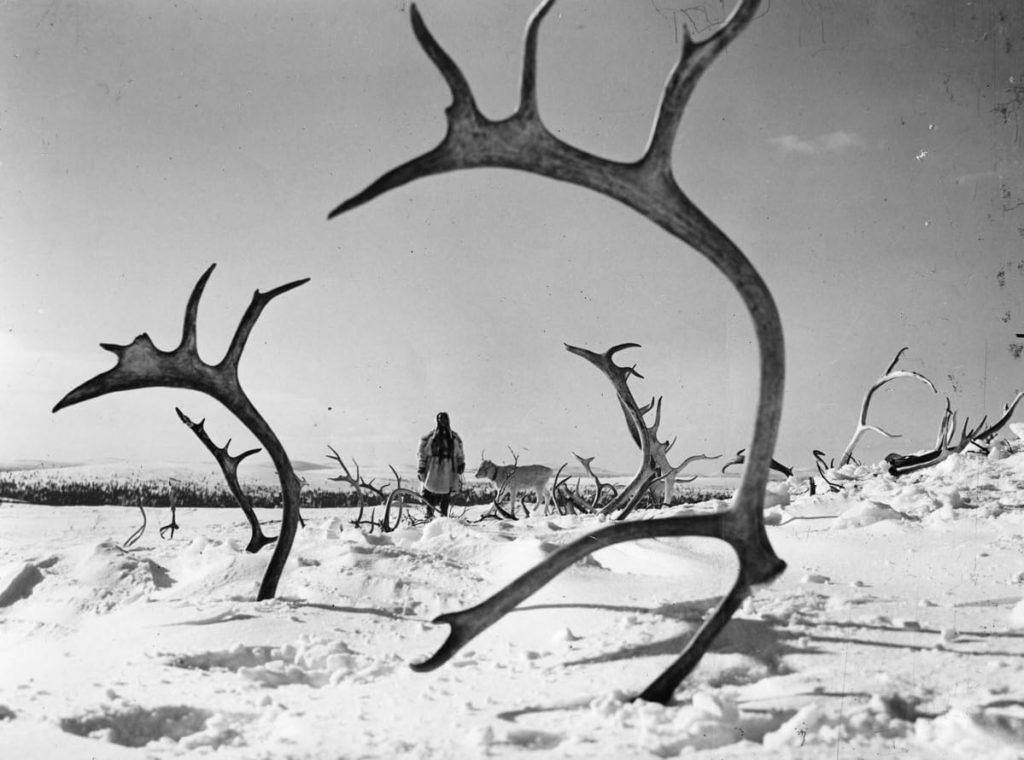
Rating: C+
Dir: Erik Blomberg
Star: Mirjami Kuosmanen, Kalervo Nissilä, Åke Lindman, Arvo Lehesmaa
a.k.a. Valkoinen peura
There were not a lot of qualifying options for 1952. Only four horror films reached the required thousand votes on the IMDb, and those included Bela Lugosi Meets a Brooklyn Gorilla and another late career Lugosi embarrassment, Mother Riley Meets the Vampire. The other was The Black Castle, which did star a couple of other genre legends, Boris Karloff and Lon Chaney Jr. It had a lower rating, though might have been more clearly in the horror genre. Still, I had thoroughly enjoyed Return of the Witch, which came from the same country and the same year as this. [It had only 521 votes incidentally] So I figured I’d roll the dice on The White Reindeer.
It’s likely more horror adjacent, although I have included less in previous 31 Days features. I got a distinct vibe of Cat People, and similar to that, I’d be interested in a modern remake, which could do more than vaguely hint at the sexual and violent undercurrents. It unfolds up in Lapland, which sits across the top of Norway, Sweden, Russia and Finland. There, the Sami people have lived their traditional ways, herding reindeer, largely unchanged for centuries. We begin with a prologue which sees a witch, Maarita (Kuosmanen), pass on her newborn daughter Pirita to a Sami couple. This unfolds mostly courtesy of high-pitched warbling on the soundtrack, which set my teeth in edge, and seemed to annoy our Bengal kitteh. Maybe Bela Lugosi Meets a Brooklyn Gorilla wasn’t so bad?
 Fortunately, things settle down. We jump forward to when Pirita (also Kuosmanen) is all grown-up. She meets, falls in love with, and marries Aslak (Nissilä), a young reindeer herder. He has to leave his new bride for reindeer herding purposes, which leaves her feeling lonely and lost. She visits the local shaman, Tsalkku-Nilla (Lehesmaa), to get a spell that will keep her husband by her side. He instructs her that, to complete the ritual, she must sacrifice the first living thing she sees. This turns out to be a rare white reindeer, but – perhaps due to Pirita’s ancestry – things go wrong. While she is now phenomenally attractive to men, each full moon she transforms into the white reindeer. When caught, she turns back to human, and is compelled to kill her captor.
Fortunately, things settle down. We jump forward to when Pirita (also Kuosmanen) is all grown-up. She meets, falls in love with, and marries Aslak (Nissilä), a young reindeer herder. He has to leave his new bride for reindeer herding purposes, which leaves her feeling lonely and lost. She visits the local shaman, Tsalkku-Nilla (Lehesmaa), to get a spell that will keep her husband by her side. He instructs her that, to complete the ritual, she must sacrifice the first living thing she sees. This turns out to be a rare white reindeer, but – perhaps due to Pirita’s ancestry – things go wrong. While she is now phenomenally attractive to men, each full moon she transforms into the white reindeer. When caught, she turns back to human, and is compelled to kill her captor.
Initially, the locals are able to write off the deaths as victims of the harsh landscape in which they live. However, it eventually becomes clear there’s something evil behind the killings, and it’s supernatural in nature. Which means bullets can’t kill whatever it is, only cold iron. [That’s a belief which has long been a staple of mythology in many cultures. Cinematically, a variant shows up in both Quatermass and the Pit and Lifeforce] So understandably, Pirita gets a bit nervous when she sees her husband and other villagers having themselves a spear-forging party. No prizes for guessing whether or not it ends well for all concerned. This is a Finnish movie, after all. The poster is almost a spoiler.
What this shares with Cat People goes beyond the obvious transformation into an animal. Pirita and Irena are tragic heroines, the subject of forces outside of their control, which force them to take human life. In both, it’s her ancestry which is the problem: if Pirita had not been a witch’s daughter, the spell cast on her might have worked as intended. Though this choice does separate her from Irena, who is entirely innocent of any culpability for her situation. Pirita may not have chosen to become a were-reindeer, yet if she had been content with her lot in life, in particular her marriage, and avoided requesting the use of the dark arts, everything would probably have been fine. Characters behaving sensibly and with caution is not how horror works though.
There are points where this feels more like a Disney True-Life Adventure, about the life of reindeer farmers in the Arctic. I almost expected to see footage of lemming streaming off a cliff. For instance, there’s extended footage of a race where reindeer pull sledges. Though this is where Pirita first comes to Aslak’s attention, it occupies rather more of a film which only runs for sixty-four minutes, than seems justified. It takes a while to get past scenes of Sami life (they seem to like wrestling with their livestock!), and settle down into the main plot, beginning with Pirita’s visit to Tsalkku-Nilla. Matters aren’t helped by the only copy of this I could find, having subtitles that tended to show up when they wanted to, in relation to the dialogue – if they bothered to appear at all.
 However, it’s not exactly a chatty film, and two elements work strongly in its favour. The first is some very good black and white cinematography from Blomberg, who edited it as well, and was married to lead actress Kuosmanen, who co-wrote the film with him. This really captures the bleak beauty of the frozen landscape (above): it feels like shooting it in colour would be a waste of film stock. I also really liked the soundtrack – well, once we got past the early warbling, anyway. Einar Englund composes a beautiful orchestral score, which provides background atmosphere, filling in for the lack of dialogue nicely.
However, it’s not exactly a chatty film, and two elements work strongly in its favour. The first is some very good black and white cinematography from Blomberg, who edited it as well, and was married to lead actress Kuosmanen, who co-wrote the film with him. This really captures the bleak beauty of the frozen landscape (above): it feels like shooting it in colour would be a waste of film stock. I also really liked the soundtrack – well, once we got past the early warbling, anyway. Einar Englund composes a beautiful orchestral score, which provides background atmosphere, filling in for the lack of dialogue nicely.
There are almost no effects to speak of here, with her transformations achieved entirely in the edit. It’s a bit of a mixed blessing, and may be the area this had aged least well, together with Kuosmanen’s performance, which seemed to me rather stiff and limited. No question, I preferred Return of the Witch, yet after a wobbly beginning, I found myself being drawn into its odd mix of folk horror, romance and neo-realism. Finnish horror films are not common to begin with; one set among the Sami people is rarer still, and I appreciated a look into a culture with which I wasn’t familiar.
This article is part of our October 2025 feature, 31 Days of Vintage Horror.
